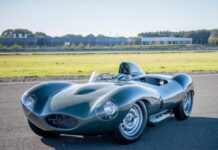One of the most famous and recognised names in motorsport is that of Chevron cars despite the company’s tragically brief history (although it later resurfaced amidst assorted unfortunate legal claims to ownership of the name). Founded in 1965 by Derek Bennett, a skilled engineer from Manchester, the first cars built, as with many such race constructors of the era, were uncomplicated Clubmans sports cars, supported eventually with a few Formula 3 and GT models albeit in the case of the latter category, the Chevron B4 was to be a one-off.

This led to the creation of the first successful sports prototype built by Chevron, the B8 that arrived in 1967. Over the course of two years, B8’s won 44 races and continued to compete for a further ten years. As the company’s reputation grew, Bennett took the opportunity to expand further into international motorsport by creating a new design for the forthcoming FIA Group 6 2-litre European Sports Car Championship scheduled for 1970. Drawing on aircraft principles he built a semi-monocoque spaceframe chassis strengthened with aluminium panels and announced the arrival of the Chevron B16. It was powered by a Ford-Cosworth FVA 1800cc engine mounted centrally behind the driver. The sleek, elegant bodywork was created by Jim Clark, a fabricator employed by Specialised Mouldings. Its strong resemblance to the ill-fated McLaren M6 GT was no accident as it was one of Jim Clark’s designs. The B16 looked fast and, thanks in part to its driver Brian Redman, its first outing at the Nurburgring 500km in 1969 saw the prototype demonstrate its potential by beating all the Abarths that had dominated the 2-litre category. During 1970 and 1971, Chevron built a total of 23 B16’s before the car was modified to become an open-topped ‘spyder’ in the manner of the Porsche 908. Initially competitive, the slightly heavier bodywork became a hindrance and Brian Redman advocated chopping the roof off. From 1973 Chevron moved into building Formula 2 and 3 cars with considerable success but when the company was at its height in 1978 its founder, Derek Bennett, died in a hang-gliding accident.
Chevron B16, chassis number 04, was purchased by a former saloon car driver, Brian Robinson, who undertook a full programme of racing during 1970 that began in the USA with the Daytona 24 Hours (retired due to fuel injection problems) followed by the Sebring 12 Hours (accident) before returning to Europe where he entered a further 31 races, usually placing in the top ten. For 1971 he campaigned the car around Europe, taking part in a further 24 races with reasonable success and gaining a 13th place finish at the BOAC 1000km that year. The B16 was then sold although Robinson remained faithful to the Chevron marque by purchasing the new open B21 model. He also raced this around Europe, taking in 24 races until the end of the 1973 season. The photograph shows the B16 (04) of Brian Robinson in action at Brands Hatch, 31st August 1970.
From ‘Moments in Motorsport’ by Trevor Legate.










